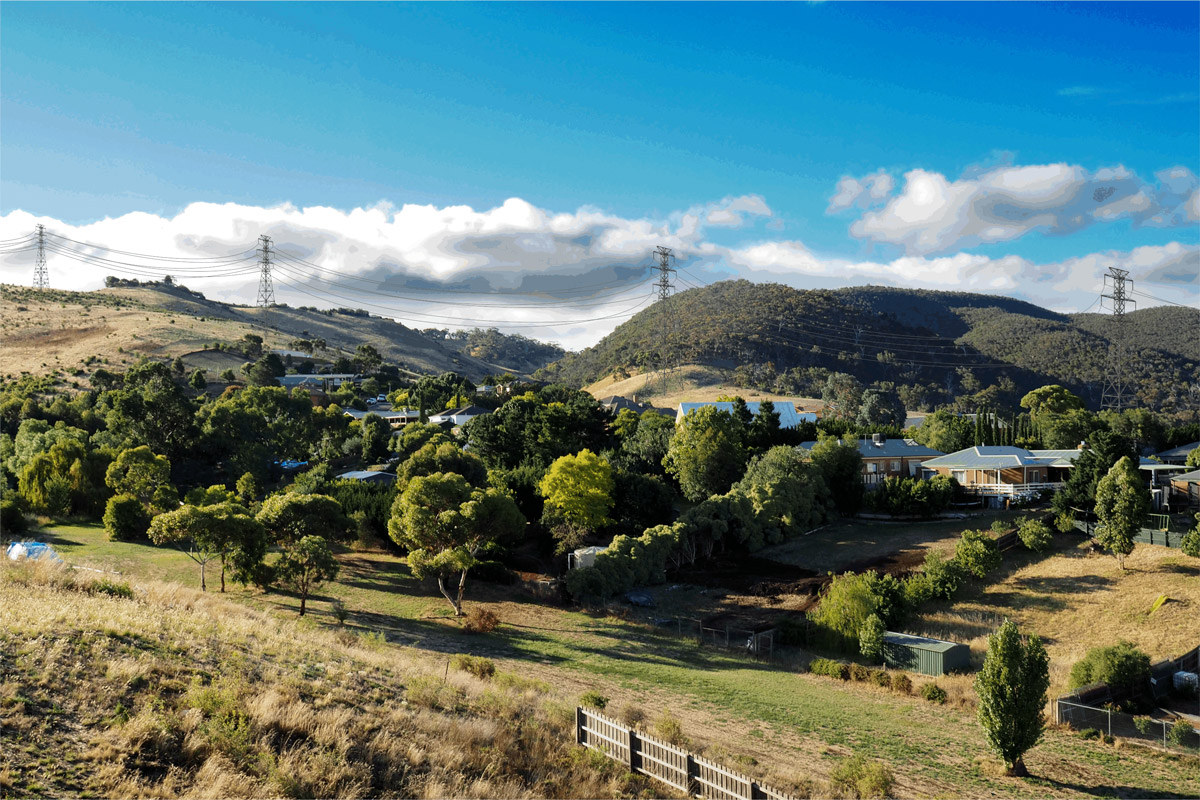Visual Amenity
A Scar on the Landscape: The Industrialisation of Rural Victoria
Overhead transmission lines permanently alter the visual landscape, replacing rolling hills, farmland, and untouched bushland with towering 80-metre-high, 500kV steel lattice towers. These structures—equivalent to a 25-storey building—will dominate the skyline, destroying the natural beauty that defines regional Victoria.
For residents, visitors, and travelers, the once-pristine views will be marred by rows of looming towers and high-voltage power lines, stretching for hundreds of kilometers. The result? A dramatic loss of rural character, turning picturesque landscapes into industrial corridors.
The Psychological and Emotional Toll
The visual impact of industrial infrastructure is more than just an eyesore—it has been linked to increased stress, anxiety, and reduced well-being among communities forced to live under its shadow. Studies show that natural landscapes have a direct positive effect on mental health, offering a sense of peace, relaxation, and connection to nature. The permanent presence of massive, intrusive steel towers disrupts this harmony, replacing scenic beauty with a constant reminder of industrialisation.
Property Values Will Plummet
The placement of high-voltage transmission lines near residential and rural properties is proven to decrease property values. Studies have shown that properties near large-scale power lines experience:
- Reduced desirability—buyers are less likely to invest in areas with industrial infrastructure
- Lower resale value—homes near power lines sell for significantly less than comparable properties further away
- Potential difficulty selling—many buyers refuse to purchase land near high-voltage lines due to visual impact, health concerns, and fire risks
For rural landowners, this means direct financial loss—one that will never be recovered.
Tourism and Local Economies at Risk
Victoria’s countryside is renowned for its stunning landscapes, eco-tourism, and regional attractions. Tourists come to experience unspoiled nature, whether it’s hiking, cycling, wine regions, or historic towns. The presence of towering industrial power lines will deter visitors, impacting businesses that rely on tourism, including:
- Wineries and agritourism ventures
- Eco-lodges, bed & breakfasts, and farm stays
- Outdoor recreation businesses (hiking, camping, adventure tours)
The economic consequences for small towns and regional communities will be severe and long-lasting.
A Legacy of Visual Pollution
Unlike underground transmission alternatives, overhead transmission lines create permanent visual pollution. Unlike roads or buildings, they cannot be hidden, landscaped, or blended into the environment. These massive towers and power lines will cut through:
- State-significant environments and national parks
- Scenic farmlands and rolling hills
- Historic townships and cultural heritage sites
Once constructed, these towers will stand for generations, forever altering Victoria’s landscape.
A Better Alternative: Underground Transmission
Modern infrastructure projects around the world prioritise underground transmission to protect visual amenity and reduce environmental impact. Victoria deserves the same consideration. Underground transmission is:
✅ Visually invisible—preserving natural beauty and protecting property values
✅ Safer—reducing fire risks, storm damage, and maintenance issues
✅ More sustainable—minimising disruption to wildlife, tourism, and local economies
Governments and energy companies must invest in responsible, future-proof solutions that balance energy needs with community and environmental protection.
Protect Victoria’s Iconic Landscape
The Western Renewables Link threatens to industrialise some of Victoria’s most treasured landscapes, sacrificing natural beauty, tourism, and rural prosperity for an outdated infrastructure model. We must demand better—before it’s too late.

